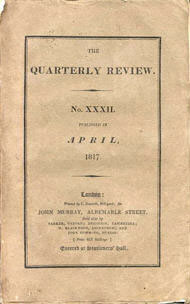Quarterly Review
 |
|
| First issue | March 1809 |
|---|---|
| Final issue | 1967 |
| Company | John Murray II |
| Country | United Kingdom |
| Language | English |
The Quarterly Review was a literary and political periodical founded in March 1809 by the well known London publishing house John Murray. It ceased publication in 1967.
Initially, the Quarterly was set up primarily to counter the influence on public opinion of the Edinburgh Review. Its first editor, William Gifford, was appointed by George Canning, at the time Foreign Secretary, later Prime Minister.
Early contributors included the Secretaries of the Admiralty John Wilson Croker and Sir John Barrow, the Poet Laureate Robert Southey, the poet-novelist Sir Walter Scott, the Italian exile Ugo Foscolo, the Gothic novelist Charles Robert Maturin, and the essayist Charles Lamb.
Under Gifford, the journal took the Canningite liberal-conservative position on matters of domestic and foreign policy, if only inconsistently. It opposed major political reforms, but it supported the gradual abolition of slavery, moderate law reform, humanitarian treatment of criminals and the insane, and the liberalizing of trade. In a series of brilliant articles in its pages, Southey advocated a progressive philosophy of social reform. Because two of his key writers, Scott and Southey, were opposed to Catholic emancipation, Gifford did not permit the journal to take a clear position on that issue.
Reflecting divisions in the Tory party itself, under its third editor, John Gibson Lockhart, the Quarterly became less consistent in its political philosophy. While Croker continued to represent the Canningites and Peelites, the party's liberal wing, it also found a place for the more extremely conservative views of Lords Eldon and Wellington.
During its early years, reviews of new works were sometimes remarkably long. That of Henry Koster's Travels in Brazil (1816) ran to forty-three pages.
...
Wikipedia
